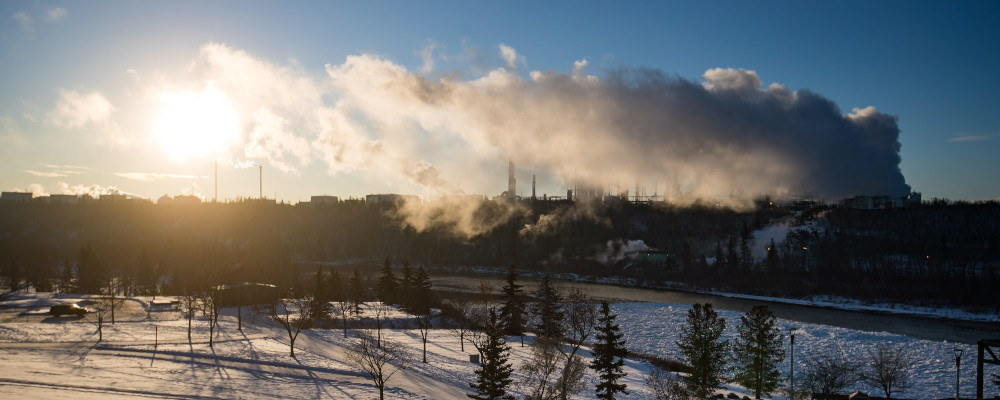Ottawa’s plan to cap greenhouse gas emissions from the oil and gas sector—largely in Alberta—has prompted no shortage of debate and analysis.
As I’ve written previously for The Hub, I think such a policy is dangerously counterproductive and unnecessarily costly. But that’s just my view. There are thoughtful arguments on the other side worth considering carefully, to be clear, such as this one by my University of Calgary colleague Professor Sara Hastings-Simon and co-authors.
But within the public discussion, I can’t help but observe that what seems to motivate some, including some political leaders, is a narrow regional view of Canada.
Climate policy isn’t cheap, so it’s natural to want others to pay for it. Excess burdens on Alberta’s oil and gas sector are far away, as the thinking may go, and can therefore be safely ignored.
This neglects an important truth: Canada’s provincial economies are deeply interconnected. Shocks to one spillover onto others. And decisions we each make every day are tied to activity thousands of kilometres away.
To see this most clearly, consider the volume of interprovincial trade.
Many sectors purchase significant amounts from outside their own province. In 2019, I estimate residential building construction, for example, purchased nearly $12 billion across provincial boundaries. Banks and other financial institutions, about $15 billion. And the resource sector, including mining, nearly $18 billion.
This matters. Housing market developments in Vancouver and Toronto have cascading effects across the country. B.C. home builders bought nearly $3 billion in goods and services from other provinces, just behind their Ontario counterparts, who imported $3.3 billion from elsewhere.
Add all this up, and the scale of each province’s economic footprint elsewhere can be considerable. I find that B.C.’s purchases from and sales to Ontario, for example, are equivalent to nearly 14 percent of its entire economy in 2019. For Quebec, their trade with Ontario is equivalent to over 21 percent.
Even small economies can matter elsewhere. PEI accounts for about $1.2 billion in sales by Ontario firms and another $2 billion from firms in other provinces.
In the West, I find that B.C.’s purchases from and sales to Alberta are equivalent to nearly 12 percent of its entire economy in 2019. For Ontario, their trade with Alberta is equivalent to nearly 7 percent.
Oil and gas is a big part of this story—with magnitudes that might surprise many.
In 2019, for example, I estimate Alberta’s oil and gas extraction sector bought about $8.8 billion in goods and services from companies outside Alberta. Add in refined product producers, and this rises to $13 billion. Of this, almost $5.5 billion came from Ontario alone. Suppliers cover a broad range of sectors, including over $1 billion in banking and insurance services, nearly $900 million in manufactured goods, $460 million in computer system design, and much more.
These purchases are large. For comparison, Ontario’s entire auto sector purchases just under $2.7 billion from suppliers in other provinces.
Why does all this matter? Trade is an important channel for shocks, both positive and negative, to ripple throughout the Canadian economy.
So consider again the oil and gas emissions cap. Soon, this sector will be required to lower emissions at higher costs than what could be done elsewhere in the economy. If this lowers productivity in that sector, as it almost surely will, then it won’t just be Alberta that feels the strain.
I estimate that a 10 percent hit to productivity in the oil and gas extraction sector shrinks Canada’s economy by approximately 1.2 percent. That’s equivalent to roughly $35 billion per year, or nearly $900 per person per year.It’s too soon to know what the emissions cap might actually mean for productivity in the sector; I use 10 percent only to illustrate the point.
Much of the decline is in Alberta and Saskatchewan, of course. But I estimate over 40 percent of the economic costs are borne by other provinces—and nearly one-quarter by Ontario alone. In fact, every single province is negatively affected. A 10 percent productivity hit to oil and gas, for example, lowers Ontario’s overall productivity by over 0.6 percent and shrinks the Atlantic provinces by roughly 0.5 percent.

This doesn’t imply oil and gas should receive special treatment. Not at all. But if the goal is to single it out for special burdens, hoping to avoid the cost, that is unlikely to happen.
The cheapest approach for the country as a whole is a uniform one, where all regions and sectors are treated equally. Instead, Quebec still lags behind the rest of the country while the government ratchets up costs for a single sector concentrated in Alberta. Canada’s productivity will further suffer as a result.
While the emissions cap is merely the most recent example of inefficient and regionally targeted federal policies, it’s not the only one. Nor will it be the last. And it’s certainly fair enough if such policies aim to achieve other important objectives. But in the case of the cap, it is not clear what those are. It seems instead that at least part of the political appeal is a desire to shift the burden elsewhere.
But narrow regional approaches can still lead to unintended consequences right across the entire country. Even if people don’t realize it.
Recommended for You

‘A celebration of the spirit of Alberta’: Ryan Hastman on the political, economic, and cultural importance of the Calgary Stampede

‘Can we actually be an independent country?’: Michael Ignatieff on the 60th anniversary of Lament for a Nation

Fred DeLorey: Why the NDP may be in even bigger trouble than we think

DeepDive: Canada desperately needs its own Department of Government Efficiency—but one with a heart




